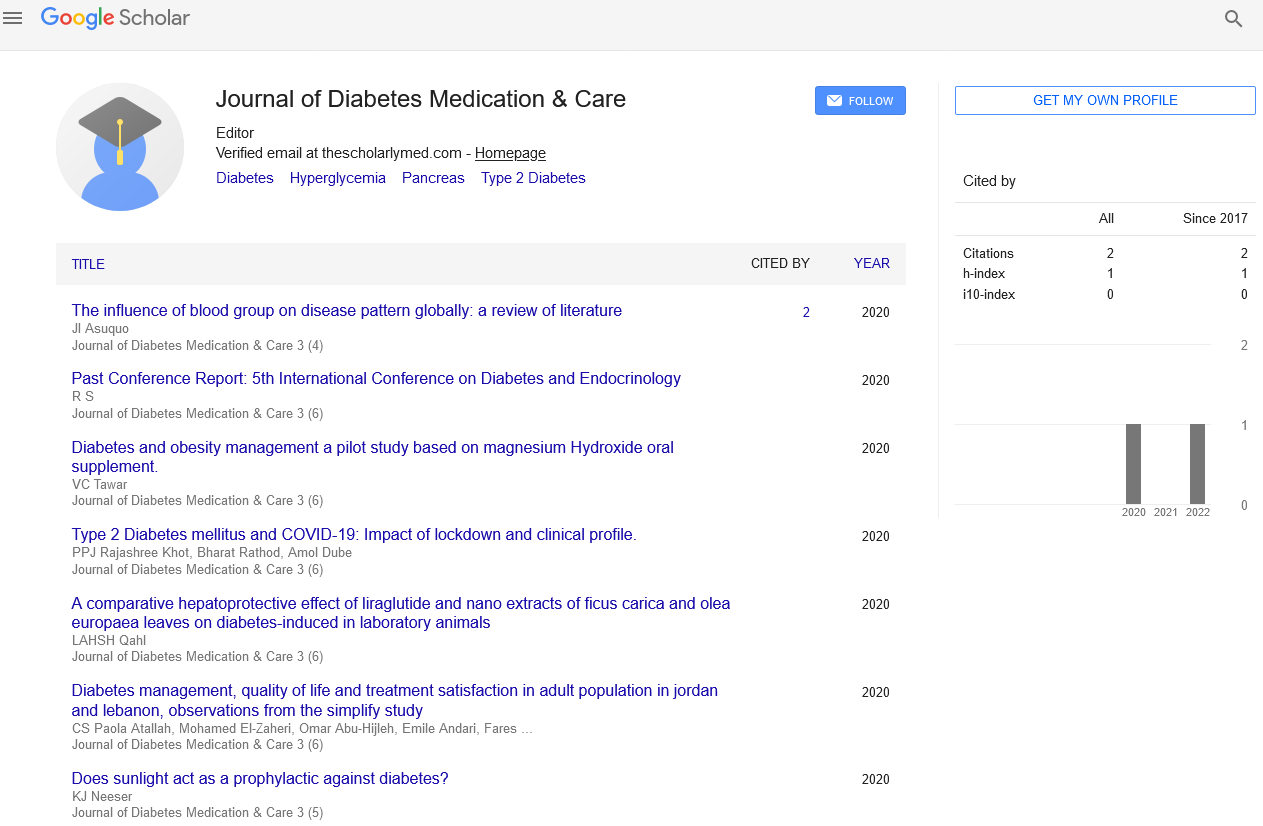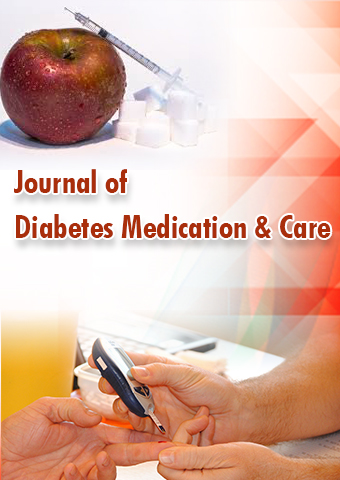Opinion Article - Journal of Diabetes Medication & Care (2024) Volume 7, Issue 5
Dapagliflozin and Heart Health: A New Era in Cardiovascular Protection
- Corresponding Author:
- Suxg Cao
Department of Diabetology, University in California, California, USA
E-mail: suxgao@sicau.edu.cn
Received: 05-Sep-2024, Manuscript No. JDMC-24-148352; Editor assigned: 09-Sep-2024, PreQC No. JDMC-24-148352 (PQ); Reviewed: 23-Sep-2024, QC No. JDMC-24-148352; Revised: 08-Oct-2024, Manuscript No. JDMC-24-148352 (R); Published: 15-Oct-2024, DOI: 10.37532/JDMC.2024.7(5).261-262
Introduction
Dapagliflozin, a member of the Sodium-Glucose co-Transporter 2 (SGLT2) inhibitor class, has emerged as a ground breaking treatment not only for type 2 diabetes but also for its significant cardiovascular benefits. Originally approved for the management of diabetes, recent research has illuminated its potential to improve heart health and reduce the risk of cardiovascular events. This article explores the mechanisms by which dapagliflozin supports heart health, its clinical implications, and its role in contemporary cardiovascular care.
Description
Understanding dapagliflozin
Dapagliflozin works by inhibiting the SGLT2 protein in the kidneys, which plays a crucial role in glucose reabsorption. By blocking this protein, dapagliflozin facilitates the excretion of excess glucose in the urine, lowering blood sugar levels. Beyond its antidiabetic effects, dapagliflozin has been shown to have a beneficial impact on cardiovascular health, particularly in patients with heart failure and those at high risk for cardiovascular disease.
The connection between diabetes and heart health
Diabetes and Cardiovascular Disease (CVD) are intricately linked. Individuals with diabetes are at a significantly higher risk of developing heart related complications due to factors such as insulin resistance, obesity, hypertension, and dyslipidemia. Traditional diabetes treatments often fall short in addressing the cardiovascular risks associated with the disease, which has prompted the need for new therapeutic strategies that target both glycemic control and cardiovascular health.
Clinical evidence supporting dapagliflozin’s cardiovascular benefits
Clinical trials and research findings: The cardiovascular benefits of dapagliflozin have been substantiated by several large scale clinical trials. One of the most pivotal studies, the DAPA-HF trial, evaluated the effects of dapagliflozin on patients with Heart Failure with reduced Ejection Fraction (HFrEF) irrespective of diabetes status. The results demonstrated that dapagliflozin significantly reduced the risk of cardiovascular death and hospitalization for heart failure. This trial set the stage for dapagliflozin as a critical option in the management of heart failure.
Another important study, the DECLARE-TIMI 58 trial, examined dapagliflozin’s effects on cardiovascular outcomes in a broader population of patients with type 2 diabetes. The findings revealed that dapagliflozin not only lowered HbA1c levels but also reduced the incidence of Major Adverse Cardiovascular Events (MACE), including heart attack and stroke. This trial reinforced the drug’s dual benefit in managing both diabetes and cardiovascular health.
Mechanisms of action
The cardiovascular benefits of dapagliflozin can be attributed to several mechanisms:
Diuresis and volume reduction: Dapagliflozin promotes osmotic diuresis, leading to reduced fluid overload in patients with heart failure. This helps alleviate symptoms and improve exercise tolerance.
Weight loss: The medication often results in modest weight loss, which can have positive effects on cardiovascular risk factors. Reducing excess body weight contributes to improved blood pressure and lipid profiles.
Lowering blood pressure: Dapagliflozin has been shown to produce mild reductions in blood pressure, providing an additional cardiovascular protective effect.
Improved endothelial function: Research suggests that SGLT2 inhibitors, including dapagliflozin, may enhance endothelial function, which is crucial for maintaining vascular health.
Broader implications for heart failure management
Dapagliflozin as a standard of care: The emerging evidence surrounding dapagliflozin’s cardiovascular benefits has prompted experts to consider it a standard treatment option for patients with heart failure, especially those with HFrEF. Its inclusion in heart failure guidelines reflects a shift towards more integrated approaches that prioritize heart health in patients with diabetes.
Expanding patient populations: While dapagliflozin was initially developed for diabetes management, its efficacy in heart failure opens up new treatment avenues for non-diabetic patients. Individuals with heart failure, regardless of diabetes status, can potentially benefit from dapagliflozin, making it a versatile therapeutic option.
Multi-faceted treatment approach
Dapagliflozin’s role in managing heart health complements other cardiovascular therapies. For instance, it can be used alongside ACE inhibitors, beta-blockers, and diuretics, creating a comprehensive treatment regimen that addresses multiple aspects of heart failure.
Patient considerations and safety profile
Side effects: While dapagliflozin is generally well-tolerated, it is not without risks. Common side effects include Urinary Tract Infections (UTIs) and genital mycotic infections, primarily due to the increased glucose concentration in the urine. Patients should be counseled on recognizing symptoms of these infections and the importance of maintaining good hygiene.
Monitoring kidney function: Dapagliflozin is also associated with renal effects. While it can be beneficial for patients with kidney disease, monitoring kidney function is essential, particularly in those with pre-existing conditions. Adjustments to therapy may be necessary based on renal function.
Patient education: Educating patients about the benefits and potential risks of dapagliflozin is critical. Patients should be informed about the signs of infection, the importance of adherence to therapy, and regular follow-up appointments to monitor their condition.
Future directions in research
As our understanding of dapagliflozin continues to evolve, ongoing research is exploring its potential benefits beyond heart failure and diabetes. Future studies may focus on:
Long term outcomes: Investigating the long-term effects of dapagliflozin on cardiovascular health in diverse populations, including those with different comorbidities.
Combination therapies: Exploring the synergistic effects of dapagliflozin when used in combination with other diabetes and heart failure medications. Mechanistic studies: Delving deeper into the molecular mechanisms through which dapagliflozin exerts its cardiovascular benefits to better understand its role in heart health.
Real world evidence: Collecting data from real-world settings to assess the effectiveness and safety of dapagliflozin in routine clinical practice.
Conclusion
Dapagliflozin represents a significant advancement in the management of both diabetes and cardiovascular health. Its dual action as a glucose lowering agent and a cardiovascular protector underscores the importance of holistic treatment approaches for patients with chronic conditions. As research continues to unveil the complexities of dapagliflozin’s benefits, it is poised to become a cornerstone in the management of heart failure and an essential component of diabetes care. This evolving landscape emphasizes the need for healthcare providers to remain informed about emerging therapies and to prioritize integrated care that addresses both metabolic and cardiovascular health.

